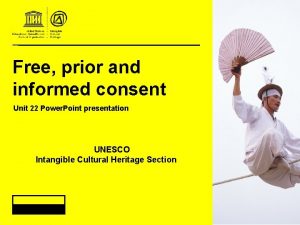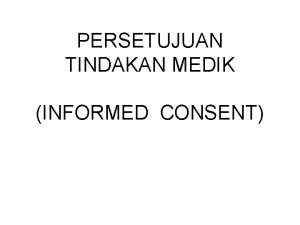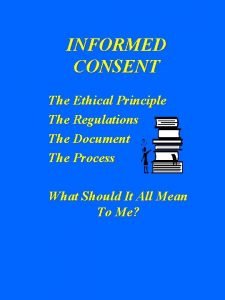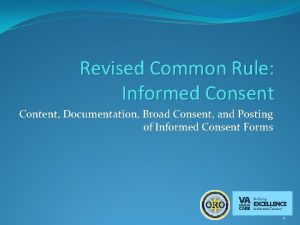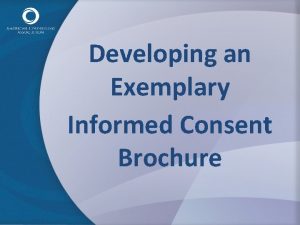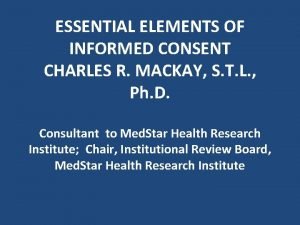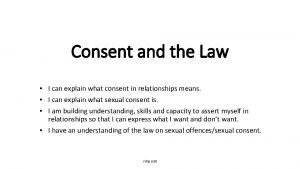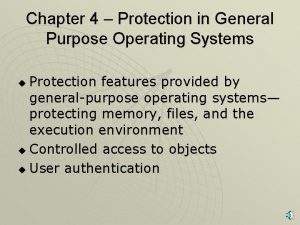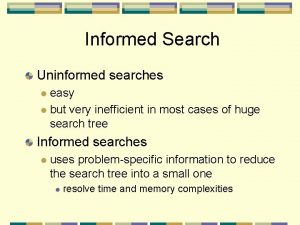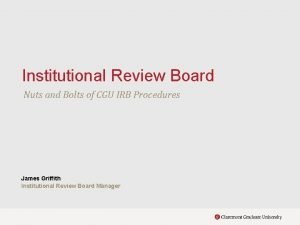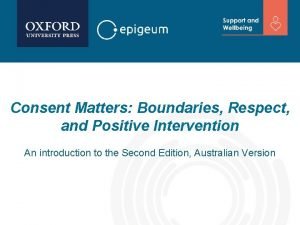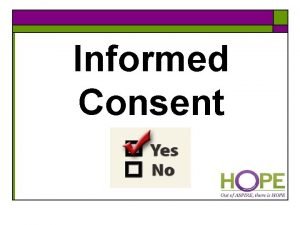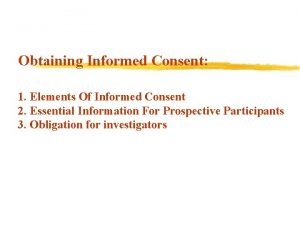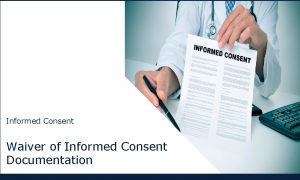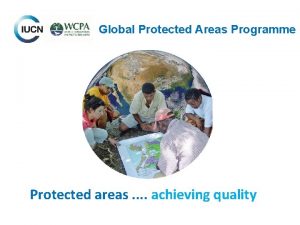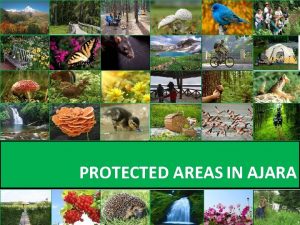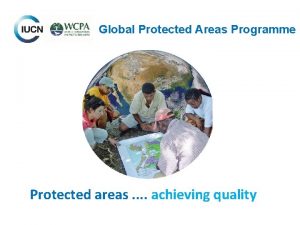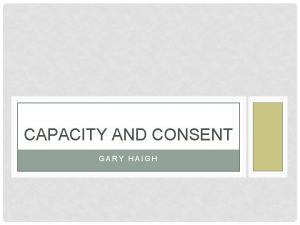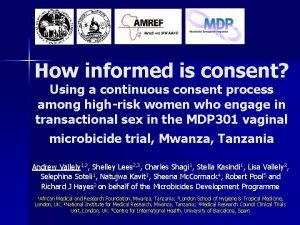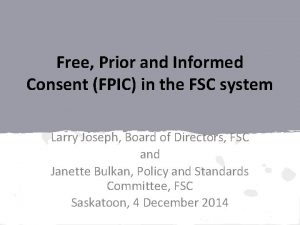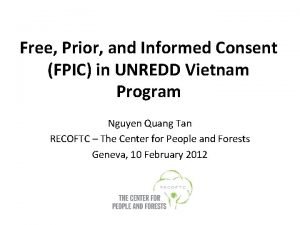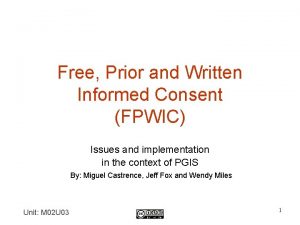Communities Protected Areas and Prior Informed Consent Anne




















- Slides: 20

Communities, Protected Areas and Prior Informed Consent Anne M. Perrault Center for International Environmental Law

“Prior” • Sufficiently in advance of authorizations or activities (e. g. mining, dams, protected areas) that affect communities – Effective PIC requires engagement in upstream processes

“Informed” • Full disclosure of nature and purpose of proposed action, risks, benefits, and alternatives – In language and process that is understandable to concerned people(s) and communities – Providing understanding of rights and legal processes guiding project implementation

“Consent” • The detailed, written terms of the transparent negotiation process are agreed upon by the community – through customary processes or otherwise – Consent as a process – communities informed and consulted throughout project cycle

Prior Informed Consent “PIC” Ideally…. PIC would enable communities and project proponents to put all concerns on table in an attempt to identify solutions to problems before communities decide whether to give consent

PIC and Protected Areas • The extent to which – and how – PIC is an obligation under international law in the context of protected areas • PIC as a mechanism for community involvement in protected areas

Specific Issues Considered • Rights of States to manage natural resources • Rights of affected communities to PIC • How rights relate in practice in context of protected areas • Implications for NGOs • Implementation of PIC – examples, issues

Rights of States • Sovereign rights of State are not absolute “Sovereignty is a legal status within but not above public international law” CBD, Article 3: “States have, in accordance with the Charter of the UN and the principles of international law, the sovereign right to exploit their own resources”

Rights of Communities to PIC • International and regional instruments – Human rights – Convention on Biological Diversity (CBD) • UN Activities – UN Permanent Forum on Indigenous Issues • International Financial Institutions • Indigenous Declarations, Charters, etc.

Human Rights Right to… - Property - Be free from racial discrimination “no decisions. . taken without informed consent” - Culture- “effective participation in decisions”

Human Rights (cont’d) Right to… - Self Determination - Consultation (ILO 169)

Conventions and interpretations suggest PIC needed because… • Significant relationships of indigenous peoples to land • Satisfies State obligation to secure property rights, to protect culture • Ensures that, if barriers to participation exist, rights are secured and discrimination prevented – part of “special measures”

PIC for Non-Indigenous Communities? • Right to Property “Everyone has the right to property” • Right to Culture “persons belonging to such minorities shall not be denied the right…to…culture” • Right to be Free from Discrimination “engage in no. . discrimination. . against persons, or groups”

CBD • Article 8 j – “prior approval” (indigenous and other communities) for use of genetic resources • Decisions of Conference of Parties – Reference to prior informed consent in context of protected areas • Akwe: Kon – guidelines for impact assessment

State Right to Act in Public Interest • Instruments that recognize right to property, right to culture also recognize right of State to act in “public interest”

How Do Rights Relate?

Some factors that influence: • Indigenous peoples or other local communities with significant relationship to land? • Potential impact – Resettlement? Impact to culture? Impact right to use property? • Existing barriers to full participation in political processes?

Relating the Rights in Practice • Good faith and informed negotiations – seeking mutual agreement • If no mutual agreement – Justify “public interest” – Use adequate information – Ensure informed participation of communities – Consider community rights as important element of “public interest”

Significance for NGOs • Growing recognition that non-governmental entities have certain duties under international law • Reflected in: – “Norms on the Responsibilities of Transnational Corporations…” (UN Subcommission on Promotion and Protection of Rights) – OECD Guidelines on Multinational Enterprises

Summary • Sovereign rights of States not absolute – must respect, protect fulfill human rights • Rights of Indigenous Peoples and other local communities not absolute – State right to act in public interest/national interest • When strong relationship to land that roots culture, identify, etc. – good faith informed negotiations, justify public interest
 22power dot com
22power dot com Dasar hukum informed consent adalah
Dasar hukum informed consent adalah Http informed delivery usps
Http informed delivery usps Ethical principles governing informed consent process
Ethical principles governing informed consent process Advantages of informed consent
Advantages of informed consent Broad informed consent
Broad informed consent Informed consent brochure
Informed consent brochure Essential elements of informed consent
Essential elements of informed consent Progressive succession
Progressive succession Consent and the law
Consent and the law Ey2 declaration and consent form
Ey2 declaration and consent form Example of coercion
Example of coercion Real protected and virtual modes of 80386
Real protected and virtual modes of 80386 The kidneys are protected by the ribs and a cushion of fat
The kidneys are protected by the ribs and a cushion of fat Protected objects and methods of protection
Protected objects and methods of protection Informed and uninformed search in artificial intelligence
Informed and uninformed search in artificial intelligence Time and space complexity of uninformed search
Time and space complexity of uninformed search Informed and uninformed search
Informed and uninformed search Assent vs consent
Assent vs consent Ic pvusd
Ic pvusd What is positive intervention consent
What is positive intervention consent
